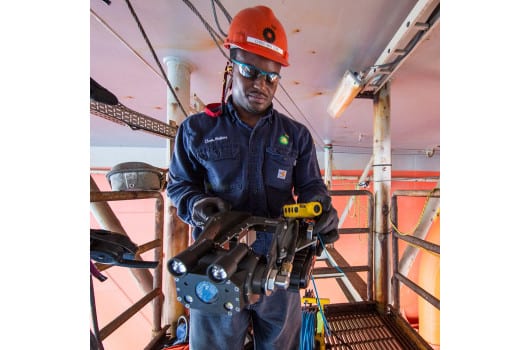(BP) Until now, offshore operators have conducted diligent inspections of facilities while clad in safety harnesses hanging off the side of an oil and gas platform. But, the latest technology is providing better solutions on BP’s Thunder Horse platform in the Gulf of Mexico – allowing crawlers and flying robots to complete these tasks instead.
In the harsh offshore environment of high winds and salty water, the fight against corrosion is a continuous battle. It requires constant vigilance with inspection teams suspended from ropes and harnesses ascending, descending and traversing all areas of the platform, from the piping at height to the dark undersides.
“It’s a very slow and tedious process,” says Bill Broman, subsea operations manager, Gulf of Mexico. “The work is also sensitive to weather conditions because rope access is only permitted during periods of calm weather, for safety reasons.”
The crews use cameras and other equipment to capture images of various sections of piping, which have to be pieced together to deliver a full view of the infrastructure. The process, while lengthy, often yields limited data.
Is there a better way to inspect?
The teams figured they could make their work more efficient, so they called in BP’s Digital Innovation Organization (DIO) to explore the possibilities. They wanted to improve the efficiency, quality and the volume of data they could collect.
The DIO team offered some options: they had been studying new technologies, including autonomous machines and digital sensors and analytics, to convert inspection activity from an observational discipline to a quantitative science.
After performing an initial trial in 2016 using a single robotic crawler, the teams reconvened to develop a more robust inspection fleet – one that included both a magnetic crawler to traverse the hull structure and a drone to inspect the side of the riser pipe that faces away from the hull.
They discovered the answer they were looking for. “Taken together, the drone and crawler were able to capture not only 360-degree views around the entire pipe, but also the imagery included useful information for surrounding structural elements,” says Dave Truch, technology director for DIO.
The tech bit: how does it work?
The crawler is equipped with strong rare-Earth magnets and a high-definition camera. No electromagnetics are used in the inspection, so even if the power were to be cut off, the crawler would still remain stuck to the hull.
The drone is built with a high-performance processor to help maintain flight controls, as well as a stabilized, high-resolution camera capable of capturing the smallest details.
It can fly within 16 to 26 feet (five to eight metres) of the piping and then zoom in on an area of interest using a powerful lens.
To help the team identify any potential hazards during the inspection, the crawler is equipped with a wireless gas detector that can send alerts up to 985 feet (300 metres) away if gas were to be detected in the area.
The drone also carries an optical gas imaging camera, a lightweight device that can ‘see’ potential gas clouds. As an additional precaution, the team uses a gas imaging camera on the platform’s catwalk to monitor the robots as well as other nearby activity.
Not just any drone…
While there are many consumer-grade drones available, Truch says only a few of the more sophisticated commercial drones on the market are capable of performing oil and gas inspections effectively. “And then, only a handful of those can do the complex work involved with offshore inspections,” he says.
The results from the trial were spectacular, according to Broman: “We collected a much larger volume of data that was significantly higher quality. The high-definition cameras on the drone and crawler enabled us to get continuous feeds of the imagery, rather than a series of slices.” He says the team was able to quickly and easily collect the inspection data required to effectively evaluate the integrity of the system.
What used to take a ropes team several weeks to complete, was done by the drone and the crawler in a matter of hours.
“With their advanced sensors, these devices can see a lot more than a human ever could,” says Truch. “In addition, the next time the robot inspects the same area, we can run comparison analytics and start predicting what that area of interest might look like in the future.”
What happens next?
Based on the pilot’s success, the Thunder Horse team aims to make changes to their inspection plans for 2018, with similar programmes under consideration for BP’s neighbouring Na Kika, Mad Dog and Atlantis platforms.




